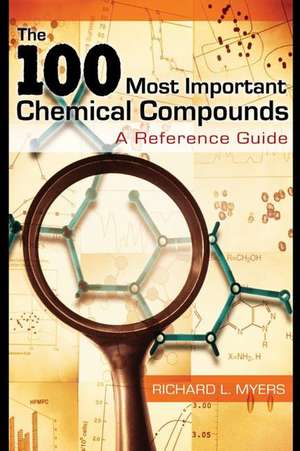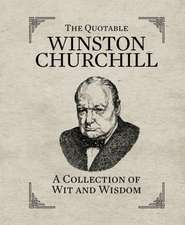The 100 Most Important Chemical Compounds: A Reference Guide
Autor Richard L. Myersen Limba Engleză Hardback – 29 aug 2007 – vârsta până la 17 ani
Preț: 400.09 lei
Preț vechi: 692.80 lei
-42% Nou
Puncte Express: 600
Preț estimativ în valută:
76.58€ • 83.21$ • 64.37£
76.58€ • 83.21$ • 64.37£
Carte tipărită la comandă
Livrare economică 21 aprilie-05 mai
Preluare comenzi: 021 569.72.76
Specificații
ISBN-13: 9780313337581
ISBN-10: 0313337586
Pagini: 352
Dimensiuni: 178 x 254 x 28 mm
Greutate: 0.88 kg
Editura: Bloomsbury Publishing
Colecția Greenwood
Locul publicării:New York, United States
ISBN-10: 0313337586
Pagini: 352
Dimensiuni: 178 x 254 x 28 mm
Greutate: 0.88 kg
Editura: Bloomsbury Publishing
Colecția Greenwood
Locul publicării:New York, United States
Notă biografică
Richard L. Myers is Professor of Environmental Science at Alaska Pacific University. He has taught chemistry, oceanography, meteorology, and physics classes and conducted research on urban environmental issues. His work has appeared in the Journal of Environmental Health,The Northern Engineer, Journal of Chemical Education, and Journal of College Science Teaching. His teaching awards include the Carnegie Foundation Alaska Professor of the Year, Higher Education Award from the United Methodist Church, President's Forum Teaching Award, and Ohaus Award for Innovations in College Science Teaching. teaches undergraduate and graduate courses in chemistry, statistics, and environmental science. Dr. Myers' published research includes work on air quality, water quality, science education, and science and the humanities.
Cuprins
PrefaceAcknowledgmentsIntroductionWhat Is a Chemical Compound?Types of Chemical CompoundsOrganic and Inorganic CompoundsIonic and Molecular CompoundsNaming CompoundsMolecular and Structural FormulasEntry Format1. Acetic Acid2. Acetone3. Acetylene4. Acetylsalicylic Acid5. Adenine6. Adenosine Triphosphate (ATP)7. Adipic Acid8. Aluminum(III) Oxide Al2O39. Ammonia10. Ascorbic Acid11. Aspartame12. Benzene13. Benzoic Acid14. Biphenyl and PCBs15. Butane16. Butene17. Butyric and Fatty Acids18. Caffeine19. Calcium Carbonate20. Calcium Oxide (Lime)21. Calcium Sulfate (Gypsum)22. Carbon Dioxide23. Carbon Monoxide24. Chloroform25. Chlorophyll26. Cholesterol27. Citric Acid28. Cocaine29. Cytosine, Thymine, and Uracil30. DDT31. DEET32. Dichlorodifluoromethane, CFC-1233. Dopamine, l-Dopa34. Epinephrine (Adrenaline)35. Ethane36. Ethene (Ethylene)37. Ether38. Ethyl Alcohol (Ethanol)39. Ethylenediaminetetraacetic Acid (EDTA)40. Fluoxetine (Prozac)41. Formaldehyde42. Formic Acid43. Glucose44. Glycerol (Glycerin)45. Guanine46. Hydrochloric Acid47. Hydrogen Peroxide48. Hydrogen Sulfide49. Ibuprofen50. Indigo51. Insulin52. Iron(III) Oxide53. Isooctane54. Isoprene55. l-Dopa. See 33. Dopamine, l-Dopa56. Methane57. Methyl Alcohol (Methanol)58. Methylphenidate (Ritalin)59. Monosodium Glutamate60. Morphine61. Naphthalene62. Nicotine63. Nitric Acid64. Nitric Oxide65. Nitrogen Dioxide66. Nitrous Oxide67. Nitroglycerin68. Norethindrone69. Penicillin70. Phenol71. Phosphoric Acid72. Piperine73. Potassium Carbonate74. Potassium Nitrate75. Propane76. Propylene77. Quinine78. Saccharin79. Silicon Dioxide (Silica)80. Sodium Bicarbonate81. Sodium Carbonate82. Sodium Chloride83. Sodium Hydroxide84. Sodium Hypochlorite85. Strychnine86. Styrene87. Sucrose88. Sulfuric Acid89. Tetrafluoroethylene90. Tetrahydrocannabinol (THC)91. Thymine. See 29. Cytosine, Thymine, and Uracil92. Trinitrotoluene (TNT)93. Toluene94. Triuranium Octaoxide95. Uracil. See 29. Cytosine, Thymine, and Uracil96. Urea97. Vanillin98. Vinyl Chloride99. Water100. XyleneCommon and Ancient Names of SubstancesGlossarySelected BibliographyIndex
Recenzii
Myers offers his criteria for inclusion on his list--compounds that were chosen because of their importance to health, industry, and society, and because of their historical impact. Although one can criticize that alternative compounds have been left off any list such as this, there are a wide variety of compounds represented, including pharmaceuticals, natural products, and commodity chemicals, alongside obvious entries such as water and ammonia. Entries are arranged alphabetically by compound name. Each entry is two to four pages long and includes basic chemical information (Chemical Abstracts Service Registry Number, select physical properties, molecular formula), followed by a narrative discussing the compound's history, significance to society, and general chemistry and use. However, the human side is not forgotten. Roles of many significant scientists, inventors, and companies are detailed in the development and use of these compounds. The book includes a concise yet informative introductory chapter dealing with basic chemistry principles and concepts, as well as a glossary and a table of common and ancient names of substances.. Recommended. General readers; lower- and upper-division undergraduates; two-year technical program students.
Giving both general and scientific information that might be useful to a variety of users, this is recommended for large public and college/university libraries, especially those serving chemistry departments.
The 100 Most Important Chemical Compounds is filled with fascinating information. It concludes with a glossary of chemical terms and an extensive bibliography. The author proposes that this book would be especially useful for science teachers and for students needing a general review of common chemical compounds. It is also a wonderful source for persons interested in the history of science.
The author has included anecdotal information about people, places, and products pertaining to the compound, as well as useful historical information..The clear writing makes this volume accessible to lay readers..A useful addition.
[T]he text in The 100 Most Important Chemical Compounds adds another dimension to information about chemicals. This title will be useful for chemistry reference collections in both large and small libraries.
Giving both general and scientific information that might be useful to a variety of users, this is recommended for large public and college/university libraries, especially those serving chemistry departments.
The 100 Most Important Chemical Compounds is filled with fascinating information. It concludes with a glossary of chemical terms and an extensive bibliography. The author proposes that this book would be especially useful for science teachers and for students needing a general review of common chemical compounds. It is also a wonderful source for persons interested in the history of science.
The author has included anecdotal information about people, places, and products pertaining to the compound, as well as useful historical information..The clear writing makes this volume accessible to lay readers..A useful addition.
[T]he text in The 100 Most Important Chemical Compounds adds another dimension to information about chemicals. This title will be useful for chemistry reference collections in both large and small libraries.







